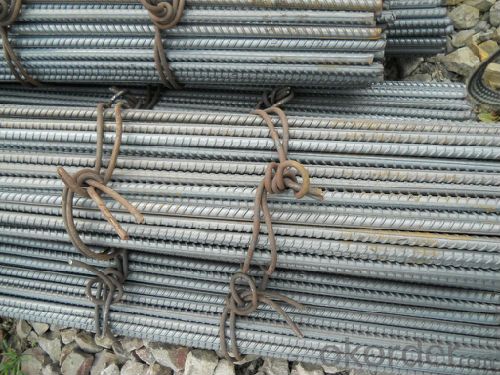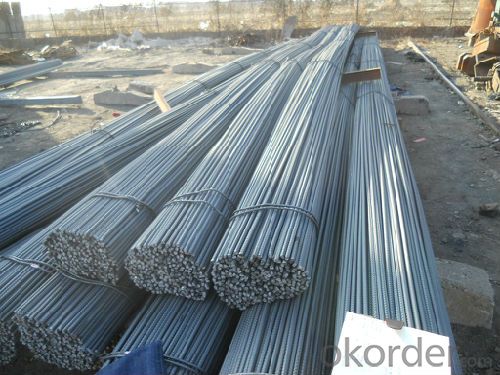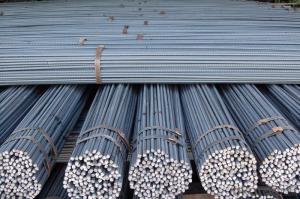GB Standard HRB400 Steel Deformed Bar 18mm/20mm
- Loading Port:
- Tianjin
- Payment Terms:
- TT or LC
- Min Order Qty:
- 50 m.t
- Supply Capability:
- 20000 m.t/month
OKorder Service Pledge
OKorder Financial Service
You Might Also Like
Steel Deformed Bar of GB Standard HRB400 Steel Deformed Bar 18mm/20mm
Description:
-Standard: GB
-Material: HRB400
-Specification:
| Diameter(mm) | Section Area(mm2) | Mass(Kg/m) | Length(m) |
| 18 | 254.5 | 2.00 | 9, 12 or as customs' request |
| 20 | 314.2 | 2.47 | 9, 12 or as customs' request |
Chemical Composition(%) of GB Standard HRB400 Steel Deformed Bar 18mm/20mm:
| C | Mn | Si | S | P | V |
| ≤0.25 | ≤1.60 | ≤0.08 | ≤0.045 | ≤0.045 | 0.04-0.12 |
Mechanical Properties of GB Standard HRB400 Steel Deformed Bar 18mm/20mm:
Yield Strength (N/cm²) | Tensile Strength (N/cm²) | Elongation (%) |
≥400 | ≥570 | ≥14 |
Usage and Applications of GB Standard HRB400 Steel Deformed Bar 18mm/20mm:
Deformed bar is widely used in buildings, bridges, roads and other engineering construction. Big to highways, railways, bridges, culverts, tunnels, public facilities such as flood control, dam, small to housing construction, beam, column, wall and the foundation of the plate, deformed bar is an integral structure material. With the development of world economy and the vigorous development of infrastructure construction, real estate, the demand for deformed bar will be larger and larger.
Packaging & Delivery of GB Standard HRB400 Steel Deformed Bar 18mm/20mm:
Packaging Detail: products are packed in bundle and then shipped by container or bulk vessel, deformed bar is usually naked strapping delivery, when storing, please pay attention to moisture proof. The performance of rust will produce adverse effect.
Each bundle weight: 2-3MT, or as required
Payment term: TT or L/C
Delivery Detail: within 45 days after received advanced payment or LC.
Label: to be specified by customer, generally, each bundle has 1-2 labels
Trade terms: FOB, CFR, CIF
Images of GB Standard HRB400 Steel Deformed Bar 18mm/20mm:


*If you would like to get our price, please inform us the size, standard/material and quantity. Thank you very much for your attention.
- Q:What are the different grades of steel rebars available in the market?
- The different grades of steel rebars available in the market include Grade 40, Grade 60, Grade 75, and Grade 80. These grades indicate the minimum yield strength of the rebars, with higher grades having a higher yield strength.
- Q:What are the different types of steel coatings used on rebars?
- There are several types of steel coatings commonly used on rebars, including epoxy, galvanized, and stainless steel.
- Q:Can steel rebars be used in underwater construction?
- Yes, steel rebars can be used in underwater construction. However, special precautions need to be taken to protect the steel rebars from corrosion due to the presence of water and other corrosive elements. Coating the rebars with corrosion-resistant materials or using stainless steel rebars are common methods to ensure their longevity and structural integrity in underwater environments.
- Q:What is the impact of steel rebars on the sustainability of a structure?
- Steel rebars have a significant impact on the sustainability of a structure. They enhance the structural integrity and durability of buildings, improving their longevity and reducing the need for frequent repairs or replacements. The use of steel rebars also allows for the construction of taller and more complex structures, optimizing space utilization and reducing the environmental footprint. Additionally, steel rebars can be recycled, promoting resource efficiency and reducing the demand for new steel production, thereby contributing to the overall sustainability of the structure and the construction industry as a whole.
- Q:What is the effect of vibration on steel rebars?
- The effect of vibration on steel rebars can lead to improved concrete consolidation and bonding, as it helps to remove air voids and ensures better adhesion between the rebar and the concrete. Vibration also helps in reducing the risk of honeycombing, enhancing the strength and durability of the reinforced concrete structure.
- Q:What are the limitations of using steel rebars?
- One limitation of using steel rebars is their susceptibility to corrosion. Over time, exposure to moisture and chemicals can cause the steel rebars to rust, which weakens their structural integrity. Additionally, steel rebars are heavy and can be difficult to handle and transport, especially in large construction projects. Lastly, steel rebars have a high thermal conductivity, which can lead to temperature changes causing expansion and contraction, potentially resulting in cracks or damage to the surrounding concrete.
- Q:How do steel rebars affect the structural capacity of concrete beams and columns?
- Steel rebars greatly enhance the structural capacity of concrete beams and columns. By reinforcing the concrete, rebars increase its tensile strength, allowing it to withstand greater loads and prevent cracking or failure. The combination of steel rebars and concrete creates a more robust and durable structure, ensuring its ability to bear heavy loads and withstand external forces.
- Q:How are steel rebars protected from concrete spalling?
- Steel rebars are protected from concrete spalling through the use of two main methods: epoxy coating and concrete cover. Epoxy coating is applied to the rebars to prevent direct contact with the concrete, forming a protective layer that prevents corrosion. Additionally, a sufficient concrete cover is provided around the rebars to shield them from environmental factors and potential damage, ensuring their long-term durability and structural integrity.
- Q:Can steel rebars be used in infrastructure projects?
- Yes, steel rebars can be commonly used in infrastructure projects. Steel rebars provide strength and durability to concrete structures, making them ideal for reinforcing various types of infrastructure such as bridges, buildings, highways, and tunnels. They help enhance the load-bearing capacity and structural integrity of these projects, ensuring their long-term stability and safety.
- Q:How are steel rebars coated with epoxy?
- Steel rebars are coated with epoxy through a process called fusion bonding. In this process, the rebars are first cleaned and preheated, and then a layer of epoxy powder is applied to their surface. The rebars are then heated to a high temperature, causing the epoxy powder to melt and fuse with the steel, creating a durable and protective coating.
1. Manufacturer Overview |
|
|---|---|
| Location | |
| Year Established | |
| Annual Output Value | |
| Main Markets | |
| Company Certifications | |
2. Manufacturer Certificates |
|
|---|---|
| a) Certification Name | |
| Range | |
| Reference | |
| Validity Period | |
3. Manufacturer Capability |
|
|---|---|
| a)Trade Capacity | |
| Nearest Port | |
| Export Percentage | |
| No.of Employees in Trade Department | |
| Language Spoken: | |
| b)Factory Information | |
| Factory Size: | |
| No. of Production Lines | |
| Contract Manufacturing | |
| Product Price Range | |
Send your message to us
GB Standard HRB400 Steel Deformed Bar 18mm/20mm
- Loading Port:
- Tianjin
- Payment Terms:
- TT or LC
- Min Order Qty:
- 50 m.t
- Supply Capability:
- 20000 m.t/month
OKorder Service Pledge
OKorder Financial Service
Similar products
New products
Hot products
Related keywords




























